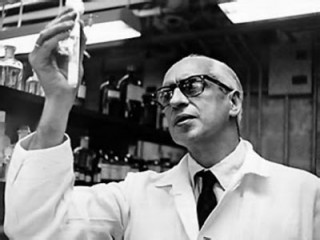
Severo Ochoa biography
Date of birth : 1905-09-24
Date of death : 1993-11-01
Birthplace : Luarca, Spain
Nationality : American
Category : Science and Technology
Last modified : 2011-12-17
Credited as : doctor and biochemist, work on the synthesis of RNA, Nobel laureate
19 votes so far
Severo Ochoa was born in Luarca (Asturias), Spain. His father was Severo Manuel Ochoa, a lawyer and businessman, and his mother was Carmen de Albornoz. Ochoa was the nephew of Alvaro de Albornoz (President of the Second Spanish Republic in exile, 1947–1951), and a cousin of the poet and literary poet and critic Aurora de Albornoz. His father died when Ochoa was seven, and he and his mother moved to Málaga, where he attended elementary school through high school. His interest in biology was stimulated by the publications of the Spanish neurologist and Nobel laureate Santiago Ramón y Cajal. In 1923, he went to the University of Madrid Medical School, where he hoped to work with Cajal, but Cajal retired. He studied with father Pedro Arrupe, and Juan Negrín was his teacher.
Negrín encouraged Ochoa and another student, José Valdecasas, to isolate creatinine from urine. The two students succeeded and also developed a method to measure small levels of muscle creatinine. Ochoa spent the summer of 1927 in Glasgow working with D. Noel Paton on creatine metabolism improving his English skills. During the summer he refined the assay procedure further and upon returning to Spain he and Valdecasas submitted a paper describing the work to the Journal of Biological Chemistry.
Ochoa completed his undergraduate medical degree in summer of 1929 and developed an interest in going abroad to gain further research experience. His previous creatine and creatinine work led to an invitation to join Otto Meyerhof’s laboratory at the Kaiser Wilhelm Institute for Biology in Berlin-Dahlem in 1929. At that time the Institute was a "hot bed" of the rapidly evolving discipline of biochemistry, thus Ochoa had the experience of meeting and interacting with scientists such as Otto Warburg, Carl Neuberg, Einar Lundsgaard, and Fritz Lipmann in addition to Meyerhof who had received the Nobel Prize in Physiology and Medicine less than a decade earlier.
In 1930 Ochoa returned to Madrid to complete research for his MD thesis, which he defended that year. In 1931, a newly minted MD, married Carmen García Cobián and began postdoctoral study at the London National Institute for Medical Research (NIMR), where he worked with Sir Henry Dale. His London research involved the enzyme glyoxalase and was an important departure in Ochoa's in two respects. First, the work marked the beginning of Ochoa's lifelong interest in enzymes. Second, the project was at the cutting edge of rapidly evolving study of intermediary metabolism.
In 1933 the Ochoas returned to Madrid where he began to study glycolysis in heart muscle. Within two years, Ochoa was offered the directorship of the Physiology Section in a newly created Institute for Medical Research at the University of Madrid Medical School. Unfortunately the appointment was made just as the Spanish civil war erupted. Ochoa wisely decided that trying to do research in such an environment would destroy forever his "chances of becoming a scientist." Thus, "after much thought, my wife and I decided to leave Spain." In September 1936 Severo and Carmen began what he later called the “wander years” as they traveled from Spain to Germany, to England, and ultimately to the United States within a span of four years.
Ochoa left Spain and returned to Meyerhof's Kaiser Wilhelm Institute for Biology now relocated in Heidelberg, where Ochoa found a profoundly changed research focus. During his 1930 visit the laboratory work was "classical physiology," which Ochoa described as “one could see muscles twitching everywhere”. By 1936 Meyerhof's laboratory had become one of the world's foremost biochemical facilities focused on processes such as glycolysis and fermentation. Rather than studying muscles "twitch," the lab was now purifying and characterizing the enzymes involved in muscle action but were involved in yeast fermentation.
From then until 1938, he held many positions and worked with many people at many places. For example, Otto Meyerhof appointed him Guest Research Assistant at the Kaiser Wilhelm Institute for Medical Research in Heidelberg for one year. From 1938 until 1941 he was Demonstrator and Nuffield Research Assistant at the University of Oxford.
He then went to America, where he again held many positions at several universities. In 1942 he was appointed Research Associate in Medicine at the New York University School of Medicine and there subsequently became Assistant Professor of Biochemistry (1945), Professor of Pharmacology (1946), Professor of Biochemistry (1954), and Chairman of the Department of Biochemistry.
In 1956, he became an American citizen. In 1959, Ochoa was awarded the Nobel Prize for Physiology or Medicine for his work on the synthesis of RNA.
Ochoa continued research on protein synthesis and replication of RNA viruses until 1985, when he returned to Spain and gave advice to Spanish science policy authorities and scientists. Ochoa was also a recipient of U.S. National Medal of Science in 1979. A new research center that was planned in the 1970s, was finally built and named after Ochoa. The asteroid 117435 Severochoa is also named in his honour. In June 2011, the United States Postal Service issued a stamp honouring him.
Severo Ochoa died in Madrid, Spain on November 1, 1993.
















